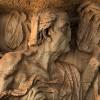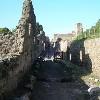3D/2D Digitization
VC Lab has a strong tradition in the context of 3D Scanning. This was exploited both in creating tools for data processing and visualization of data, and in practical experience in the context of important acquisition campaigns and several pioneering international projects. Activity on 3D acquisition started at VC Lab on mid '90s; we have designed a low-cost 3D scanner and proposed many new algorithms for processing sampled 3D data.
Most of those results later on have been incorporated in the MeshLab system, together with other geometry processing results. MeshLab is an open source system for processing and editing 3D triangular meshes; it has more than 10 years of life and a very consolidated and wide community of users (totalling more than 100,000 download every year).
We have been also active on some advanced 2D media, such as the Reflection Transformation Images (RTI):
We present below links and brief presentation of some recent results.
Acquisition and Projection of color information onto 3D Models
One of the main fields of research in the last few years has been in the necessity to add highly detailed color information to 3D geometry. In particular, the most recent works address the issues

Automatic registration of images onto 3D models.

Preserving fine details in color projection.

Registration of video sequences onto 3D models.

SVBRDF approximation from video sequences.

Analysis of High Dynamic Range Image a Focus on Inverse Tone Mapping Content

Acquisition of Natural Lighting: bringing light from the Real-World to the Virtual Domain
Reflectance Transformation Imaging (RTI)

RTI images are a valid alternative to 3D acquisition in some CH scenarios. The Lab has experience in data acquisition and visualization of RTI images.
3D Scanning Projects
We are also active on 3D digitization efforts, either commissioned by conservation institutions or restoration labs. To present some examples among recent major 3D scanning experiences we point to the following (but please navigate also the page on current CH Activities):

The acquisition of the Ruthwell Cross, in collaboration with the Visionary Cross project.

The scanning of Insula V in Pompei, in collaboration with University of Lund.

3D Scanning and acquisition of color appearance in the context of the analysis of the fractures in the lower part of Michelangelo’s David.